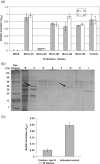A streptococcal effector protein that inhibits Porphyromonas gingivalis biofilm development
- PMID: 20705665
- PMCID: PMC7336479
- DOI: 10.1099/mic.0.042671-0
A streptococcal effector protein that inhibits Porphyromonas gingivalis biofilm development
Abstract
Dental plaque formation is a developmental process involving cooperation and competition within a diverse microbial community, approximately 70 % of which is composed of an array of streptococci during the early stages of supragingival plaque formation. In this study, 79 cell-free culture supernatants from a variety of oral streptococci were screened to identify extracellular compounds that inhibit biofilm formation by the oral anaerobe Porphyromonas gingivalis strain 381. The majority of the streptococcal supernatants (61 isolates) resulted in lysis of P. gingivalis cells, and some (17 isolates) had no effect on cell viability, growth or biofilm formation. One strain, however, produced a supernatant that abolished biofilm formation without affecting growth rate. Analysis of this activity led to the discovery that a 48 kDa protein was responsible for the inhibition. Protein sequence identification and enzyme activity assays identified the effector protein as an arginine deiminase. To identify the mechanism(s) by which this protein inhibits biofilm formation, we began by examining the expression levels of genes encoding fimbrial subunits; surface structures known to be involved in biofilm development. Quantitative RT-PCR analysis revealed that exposure of P. gingivalis cells to this protein for 1 h resulted in the downregulation of genes encoding proteins that are the major subunits of two distinct types of thin, single-stranded fimbriae (fimA and mfa1). Furthermore, this downregulation occurred in the absence of arginine deiminase enzymic activity. Hence, our data indicate that P. gingivalis can sense this extracellular protein, produced by an oral streptococcus (Streptococcus intermedius), and respond by downregulating expression of cell-surface appendages required for attachment and biofilm development.
Figures





Similar articles
-
Arginine deiminase inhibits Porphyromonas gingivalis surface attachment.Microbiology (Reading). 2013 Feb;159(Pt 2):275-285. doi: 10.1099/mic.0.062695-0. Epub 2012 Dec 14. Microbiology (Reading). 2013. PMID: 23242802 Free PMC article.
-
Role of arginine deiminase of Streptococcus cristatus in Porphyromonas gingivalis colonization.Antimicrob Agents Chemother. 2010 Nov;54(11):4694-8. doi: 10.1128/AAC.00284-10. Epub 2010 Jul 26. Antimicrob Agents Chemother. 2010. PMID: 20660674 Free PMC article.
-
Tobacco smoke augments Porphyromonas gingivalis-Streptococcus gordonii biofilm formation.PLoS One. 2011;6(11):e27386. doi: 10.1371/journal.pone.0027386. Epub 2011 Nov 14. PLoS One. 2011. PMID: 22110637 Free PMC article.
-
Intrageneric and Intergeneric Interactions Developed by Oral Streptococci: Pivotal Role in the Pathogenesis of Oral Diseases.Curr Issues Mol Biol. 2019;32:377-434. doi: 10.21775/cimb.032.377. Epub 2019 Jun 5. Curr Issues Mol Biol. 2019. PMID: 31166176 Review.
-
Bacterial adhesion to collagens: implications for biofilm formation and disease progression in the oral cavity.Crit Rev Microbiol. 2022 Feb;48(1):83-95. doi: 10.1080/1040841X.2021.1944054. Epub 2021 Jul 16. Crit Rev Microbiol. 2022. PMID: 34270375 Review.
Cited by
-
Staphylococcus aureus in Polymicrobial Skinand Soft Tissue Infections: Impact of Inter-Species Interactionsin Disease Outcome.Antibiotics (Basel). 2023 Jul 8;12(7):1164. doi: 10.3390/antibiotics12071164. Antibiotics (Basel). 2023. PMID: 37508260 Free PMC article. Review.
-
Composition of microbial oral biofilms during maturation in young healthy adults.PLoS One. 2014 Feb 4;9(2):e87449. doi: 10.1371/journal.pone.0087449. eCollection 2014. PLoS One. 2014. PMID: 24503584 Free PMC article.
-
New approaches to combat Porphyromonas gingivalis biofilms.J Oral Microbiol. 2017 Mar 15;9(1):1300366. doi: 10.1080/20002297.2017.1300366. eCollection 2017. J Oral Microbiol. 2017. PMID: 28473880 Free PMC article. Review.
-
PPAD Activity Promotes Outer Membrane Vesicle Biogenesis and Surface Translocation by Porphyromonas gingivalis.J Bacteriol. 2021 Jan 25;203(4):e00343-20. doi: 10.1128/JB.00343-20. Print 2021 Jan 25. J Bacteriol. 2021. PMID: 33257525 Free PMC article.
-
Peptide and non-peptide mimetics as potential therapeutics targeting oral bacteria and oral biofilms.Mol Oral Microbiol. 2019 Oct;34(5):169-182. doi: 10.1111/omi.12267. Epub 2019 Aug 15. Mol Oral Microbiol. 2019. PMID: 31389653 Free PMC article. Review.
References
-
- Amano A., Nakagawa I., Okahashi N., Hamada N. Variations of Porphyromonas gingivalis fimbriae in relation to microbial pathogenesis. J Periodontal Res. 2004;39:136–142. - PubMed
-
- Bradford M. M. A rapid and sensitive method for the quantitation of microgram quantities of protein utilizing the principle of protein-dye binding. Anal Biochem. 1976;72:248–254. - PubMed
-
- Burne R. A., Marquis R. E. Alkali production by oral bacteria and protection against dental caries. FEMS Microbiol Lett. 2000;193:1–6. - PubMed
Publication types
MeSH terms
Substances
Grants and funding
LinkOut - more resources
Full Text Sources
Other Literature Sources

